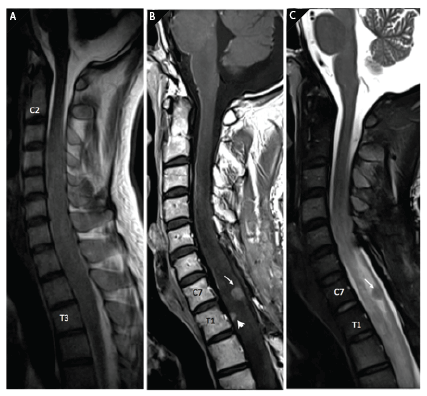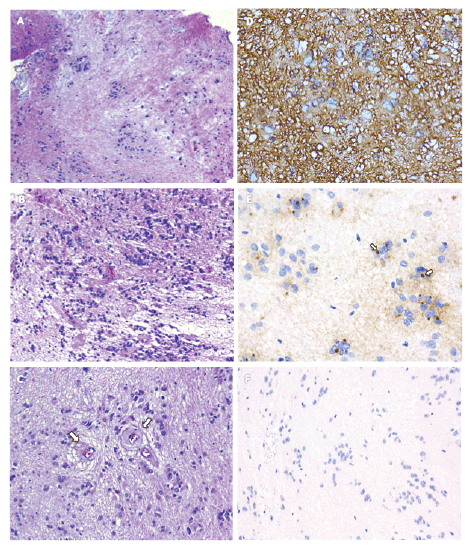Background
Subependymomas are rare, World Health Organization (WHO) grade
I tumors [1,2]. They typically arise in the ventricles and represent less
than 1% of intracranial tumors [3]. Spinal subependymomas are even less
frequent, comprising approximately 2% of all symptomatic spinal cord
tumors [4]. They are usually intramedullary and located in the cervical
region, however thoracic and lumbar lesions have also been reported
[2,5,6].
Radiologically, intracranial subependymomas present as well defined
intraventricular lesions that are classically T2-weighted images (WI)
hyper intense and T1WI hypo or isointense to white matter in MRI
[5,7]. Heterogeneity on T2WI is often reported and is related to cystic
changes, blood products or calcifications, particularly in larger lesions [5].
Calcifications and blood products can manifest as low signal intensity on
T2WI gradient echo sequence. Subependymomas typically do not enhance
or only mildly enhance. Avid enhancement has been reported particularly
in lesions located in the fourth ventricle. The tumor size typically ranges
from 1 to 2 cm, however lesions greater than 5 cm have also been reported
[2,5]. Spinal subependymomas usually present as eccentric, well-defined
lesions with mild to moderate enhancement. Lesions of the spine have
significant associated edema [2,6].
Histologically, subependymomas are characterized by the presence of
nuclear clustering and a densely fibrillar and paucicellular background
[1]. Microcysts can be present, particularly in lesions located closer to
the foramen of Monro. Subtle pseudorosettes can also be seen [1,8]. In
tumors located far from the foramen of Monro, the nuclear clustering
is more prominent. Occasionally, an ependymoma component can be
identified, although this is more common in fourth ventricle tumors.
By immunohistochemistry, subependymoma are diffusely positive for
glial fibrillary acidic protein (GFAP) which demonstrate its glial origin
and positive for epithelial membrane antigen (EMA) (showing a dot-like
pattern) which is consistent with an ependymal origin. They usually have
a low Ki-67 proliferative index, although it can be variable [1,8].
We describe a case of spinal subependymoma and discuss the clinical,
radiographic and histological characteristics.
Clinical Case
A 37-year-old-man initially presented with a 10-year-history of left
foot weakness and bilateral lower extremity pain. His symptoms worsened
over the following years including left lower extremity weakness, left
hand weakness and urinary urgency. Eighteen months before coming to
our institution, the patient had a cervical magnetic resonance imaging
(MRI) without contrast done, which showed diffuse spinal cord edema
and expansion from C2-3 to T3 level (Figure 1A). One month later, the
patient underwent C6-T1 laminectomy with tumor biopsy followed by
focal radiation therapy from C3 to T3. Pathology was read as WHO grade
II astrocytoma. He has not received any further therapy.
One year later, he moved to Miami and established care at Sylvester
Comprehensive Cancer Center/University of Miami. He did not report
any new symptoms. His physical exam revealed left upper extremity
weakness (3/5), left lower extremity weakness (4/5), generalized hyper
reflexia, positive Babinski sign bilaterally and paretic gait. Sensation was
normal. A MRI with contrast of the total spine was done and compared
to pre-operative and post-operative MRIs, revealing persistence of the
diffuse T2 hyper intensity and cord expansion extending from C4 to T3.
There was a 7 mm × 7 mm well defined intramedullary enhancing lesion
within the dorsal aspect of the cord at C7-T1. The lesion was isointense on
T2WI (Figures 1B and 1C). There was also a focus of low signal on T2WI
gradient echo sequence that likely represented blood or calcification and
a smaller lesion with similar signal within the ventral aspect of the cord
at the same level. It was difficult to compare the degree of enhancement
as there were no post-contrast sequences on the prior outside imaging.
Overall, the craniocaudal extent of the lesion did not change significantly.
These findings were consistent with a combination of residual tumor/
post treatment changes, particularly in the areas of intramedullary
enhancement, with associated post treatment changes, edema and/or
myelomalacia. There was no evidence for drop metastasis in the thoracic
and lumbar spine, and neither brain metastasis.

Figure 1: Radiological features.
A. Preoperative scan. Sagittal T2-weighted images (WI) MRI. There is cord edema and expansion between C2-C3 to T3 levels.B-C.
Postoperative scan. B. Sagittal T2WI fat saturated MRI. C. Sagittal T1WI Post contrast. There is a 7 mm × 7 mm T2 isointense solid enhancing
lesion within the dorsal aspect of the cord at C7-T1 level (arrow). A smaller lesion is seen within the ventral aspect of the cord at mid T1 level
(arrow head). Laminectomy changes are also noted.
The biopsy sample was reviewed at our institution (Figure 2). The
tumor showed nuclear clustering and a fibrillar, paucicellular background.
It was diffusely positive for GFAP immunostaining, positive for EMA
immunostaining in a dot-like pattern, and it was negative for Ki-67
immunostaining. All these finding were consistent with a subependymoma
(WHO grade I).

Figure 2: Histological features.
A. Microscopic image of the tumor demonstrating the classic features of subependymoma, including nuclear clustering and a fibrillar, paucicellular
background; Microcysts are not evident in this case (magnification 10x). B. The tumor shows areas with medium cellularity, however cell clustering
is still present (20x). C. Hyalinized vessels are observed in the specimen (arrows, 20x). D. The tumor is diffusely positive for GFAP immunostain
(40x). E. It shows dot-like EMA positivity (arrows, 40x). F. It is negative for Ki-67 immunostain (20x).
Twenty five months after his biopsy, the patient remains clinically and
radiologically stable off treatment.
Discussion
We describe a case of a young adult male with a cervicothoracic spinal
cord lesion. He presented with a 10-year history of slowly progressive
lower extremity pain, motor and urinary dysfunction. Differential
diagnosis for this lesion includes spinal cord astrocytoma, ependymoma
and subpendymoma.
Radiological features
The primary radiologic consideration in this setting was a spinal
ependymoma. These lesions represent 60% of primary intramedullary
spine lesions, are common in this age group and typically present as
well defined solid enhancing lesions [9]. Cystic component, which is
commonly seen with ependymomas, and syrinx which is associated with
50-90 % of spinal ependymomas, were both absent. Subependymomas
have been described with features identical to this case, however, since
these commonly present as non-enhancing intraventricular lesions [5,7],
it was felt to be a less likely etiology. This case serves as a reminder to
include subependymoma in the differential of a well-defined solid
enhancing intramedullary spinal lesion, particularly when low signal foci
are seen on T2WI [10].
Histological features
In spinal cord tumors located far from the foramen of Monro, the
differential diagnosis includes ependymoma, infiltrating astrocytoma,
and subependymoma. Subependymomas located in this area usually
present with a more prominent nuclear clustering and few microcysts,
if any; and these were features of our case. Even though our patient’s
tumor showed areas with increased cellularity (Figure 2B) which is a
feature of ependymoma, clustering was still noted and others features
including uniform medium to high cellularity and true rosettes were
not identified. An infiltrating astrocytoma was also ruled out due to the
lack of an infiltrating pattern, presence of nuclear clustering, and EMA
positivity [8]. Additionally, several hyalinized vessels were present in the
specimen (Figure 2C), which is a common and unspecific finding among
CNS tumors [11].
Neurosurgical approach
Surgical intervention for spinal cord ependymomas remains the
mainstay treatment option. Due to spinal cord compression from these
tumors, patients usually present with neurological deficits such as paresis,
dysesthesias, or incontinence. The goals of surgery are to obtain tissue for
diagnosis, decompression to provide symptomatic relief, and to provide
long term tumor control [2]. These tumors are usually amenable to a gross
total resection and considering their slow and benign growth, outcomes
are favorable [12,13]. Surgery entails a laminectomy with intramedullary
tumor resection. Fusion is indicated only if instability results from the
extent of bony removal during exposure. Perioperative steroids and
prophylactic antibiotics are administered before incision and steroids
are typically continued after surgery as well. Somato sensory and motor
evoked potentials are electrophysiologically monitored during the entire
tumor resection. Microsurgical technique is used to obtain a safe maximal
resection. The tumor is often, 74% of the time, in an eccentric location
with a sharp demarcation between tumor and cord, however occasionally
there can be areas where tumor can infiltrate the surround tissue making it
difficult for a gross total resection [14]. The tumor is often soft and greyish
with minimal to no vascularization. In one review series of 30 patients
with subependymomas in the spinal cord immediate postoperative
deficits were noted in 60% of patients, however, 75% of these deficits
improved on long term follow-up [14]. In a more recent series, four
of five patients had resolution of their preoperative symptoms on long
term follow-up [2]. Long term follow up after gross total resection or
maximal safe resection has shown no tumor recurrence or progression
for greater than 3 years in multiple series [2,15-17]. Therefore surgical
resection is usually curative and no adjuvant therapy recommended
during initial treatment [18].
Other therapeutical options
The role of further therapy as radiation therapy and/ or chemotherapy
remains unclear. Radiation therapy may be consider for the management
of recurrent or symptomatic residual disease [2].
Consent
Written informed consent was obtained from the patient for publication
of this case report and accompanying images.
Conflict of Interests
The authors declare that they have no conflict of interests.
Article Information
Article Type: Case Report
Citation: Maque-Acosta Y, Petito CK, Ivan ME,
Sidani C, de la Fuente MI (2016) Subependymoma of
the Cervicothoracic Spinal Cord. J Neurol Neurobiol
2(3): doi http://dx.doi.org/10.16966/2379-7150.123
Copyright: © 2016 Maque-Acosta Y, et al. This is
an open-access article distributed under the terms
of the Creative Commons Attribution License,
which permits unrestricted use, distribution, and
reproduction in any medium, provided the original
author and source are credited.
Publication history:
Received date: 18 Jan 2016
Accepted date: 10
Mar 2016
Published date: 15 Mar 2016



